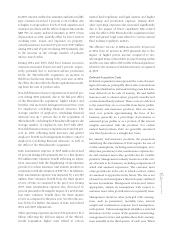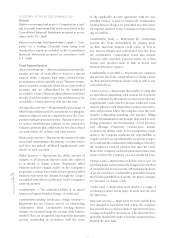American Express 2004 Annual Report Download - page 63
Download and view the complete annual report
Please find page 63 of the 2004 American Express annual report below. You can navigate through the pages in the report by either clicking on the pages listed below, or by using the keyword search tool below to find specific information within the annual report.
In May 2004, the Company reported that the broker-
dealer subsidiary of AEFA had received notification
from the staff of the NASD indicating that it had made
a preliminary determination to recommend that the
NASD bring an action against AEFA for potential viola-
tions of federal securities laws and the rules and regu-
lations of the SEC and the NASD. The notice received
by AEFA comes in the context of a broader industry-
wide review of the mutual fund and brokerage indus-
tries that is being conducted by various regulators. The
NASD staff’s allegations relate to AEFA’s practices with
respect to various revenue sharing arrangements pur-
suant to which AEFA receives payments from certain
non-proprietary mutual funds for agreeing to make
their products available through AEFA’s national distri-
bution network. In particular, the NASD has alleged
that AEFA: (i) failed to properly disclose such revenue
sharing arrangements from January 2001 until May
2003; (ii) failed to properly disclose such revenue shar-
ing arrangements in its brokerage confirmations; and
(iii) received directed brokerage from January 2001
until December 2003. The notice from the NASD staff
is intended to give AEFA an opportunity to discuss the
issues it has raised. AEFA has been availing itself of this
opportunity and continues to cooperate fully with the
NASD’s inquiry regarding this matter, as well as all
other regulatory inquiries.
In addition to the foregoing, in February 2004 AEFA
was one of 15 firms that settled an enforcement action
brought by the SEC and the NASD relating to break-
point discounts (i.e., volume discounts available to
investors who make large mutual fund purchases) pur-
suant to which AEFA paid a fine of $3.7 million and is
in the process of reimbursing customers to whom the
firm failed to deliver such discounts.
Congress has also proposed legislation and the SEC
has proposed and, in some instances, adopted rules
relating to the mutual fund industry, including
expenses and fees, mutual fund corporate governance
and disclosures to customers. For example, during the
past year, mutual fund and investment advisors were
required by the SEC to adopt and implement written
policies and procedures designed to prevent violation
of the federal securities laws and to designate a chief
compliance officer responsible for administering these
policies and procedures. While there remains a signifi-
cant amount of uncertainty as to what legislative and
regulatory initiatives may ultimately be adopted,
these initiatives could negatively impact mutual fund
industry participants’ results, including AEFA’s, in
future periods.
Liquidity and Capital Resources
SELECTED BALANCE SHEET INFORMATION (GAAP BASIS)
December 31, (Billions, except percentages) 2004 2003
Accounts receivable, net $ 5.9 $ 1.5
Investments $ 44.9 $ 42.1
Separate account assets $ 35.9 $ 30.8
Deferred acquisition costs $ 3.9 $ 3.7
Total assets $ 97.1 $ 84.6
Customers’ deposits $ 5.6 $ 1.2
Client contract reserves $ 44.3 $ 41.2
Separate account liabilities $ 35.9 $ 30.8
Total liabilities $ 90.7 $ 77.5
Total shareholder’s equity $ 6.4 $ 7.1
Return on average total
shareholder’s equity before
accounting change 11.8% 10.4%
Return on average total
shareholder’s equity 10.8% 10.2%
See Glossary of Selected Terminology section for definitions of key terms.
AEFA’s total assets and liabilities increased in 2004 pri-
marily due to higher investments, client contract
reserves and separate account assets and liabilities,
which increased as a result of new client inflows and
market appreciation. In addition, accounts receivable
and customer deposits increased due to the transfer
of the Membership Banking activity into the AEFA
operating segment (from TRS) in 2004. Investments pri-
marily include corporate debt and mortgage-backed
securities. AEFA’s corporate debt securities comprise a
diverse portfolio with the largest concentrations,
accounting for approximately 67 percent of the portfo-
lio, in the following industries: banking and finance,
utilities, and communications and media. Investments
also include $3.5 billion and $3.8 billion of investment
loans at December 31, 2004 and 2003, respectively.
Investments are principally funded by sales of insur-
ance, annuities and certificates and by reinvested
income. Maturities of these investments are largely
matched with the expected future payments of insur-
ance and annuity obligations.
Investments include $3.1 billion and $3.2 billion of
below investment grade securities (excluding net unre-
alized appreciation and depreciation) at December 31,
2004 and December 31, 2003, respectively. These
investments represent 7 percent and 8 percent of
AEFA’s investment portfolio at December 31, 2004 and
2003, respectively. Non-performing assets relative to
invested assets (excluding short-term cash positions)
were 0.02% and 0.07% at December 31, 2004 and 2003,
respectively. Management believes a more relevant
measure of exposure of AEFA’s below investment
grade securities and non-performing assets should
exclude $230 million and $236 million, at December 31,
AXP
AR.04
61
Financial Review
























